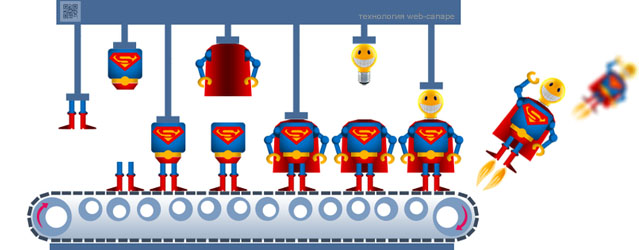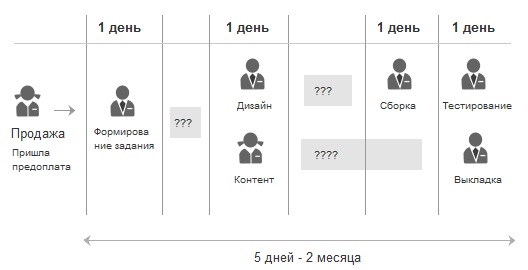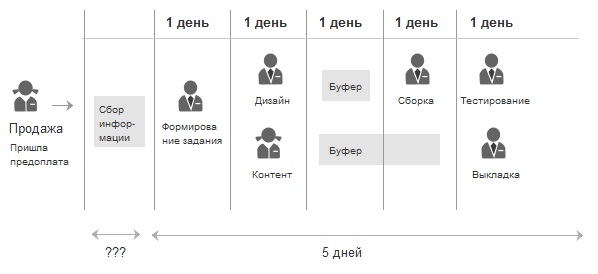Optimization of web-studio work. Application of the theory of restrictions in the production of sites

In the article “12 thousand rubles for the site. Is there a business outside the Moscow Ring Road? ”I wrote about our approach to developing websites based on the technology developed within the company. At the time of writing this article, we have released a turnkey 24 sites per month. This is more than one site per day by a team of 8 people.
After the story on Habré about our technology, the number of requests for the development of sites has increased several times. In March 2012 alone, about 60 commercial offers were submitted and, most of them turned into contracts.
')
And then our production cracked at the seams. Almost immediately, applications began to queue up, managers began to get confused in projects, designers began to ask for leave. The situation was becoming really tense ...
Awareness of the problem
The first thing we had to do was temporarily increase the promised development time from 5 to 8, and sometimes 10 days. We just had no way out. Clients reacted with understanding and were willing to wait. But we were not ready to wait until the situation becomes even more tense. It was necessary to do something. By all measures (and standards) we had to cope, but this did not happen.
We did not want to refuse customers. We could not expand the staff either. It takes time. We needed to increase our own efficiency, find hidden resources. We all calculated, they should be! In addition, it was necessary to urgently return a calm atmosphere in the team.
Continuous improvement process
Let's look at the development of sites, as in the production. Production is a chain where all links are interconnected. In our case, the chain links are: sales manager, executive manager, designer, content manager, programmer, tester. The functions of each do not paint, I think they are so clear.

One link accepts applications, another accepts a project for work, design, assembly, refinement ... another one is engaged in testing and layout, and so on. If at least one link fails, the whole process is slowed down or stopped. And there is an important point. What determines the strength of the chain? Naturally - the weakest link. It should be noted that the “most” weak link in the chain is one, and this is the key point of the approach to production management. This approach in the industrial world is described by the Theory of constraints.
I will explain in more detail. For example, in a production chain, your role is to build a site from a finished design. You are not the weakest link. As a result of your own genius and ability to work, you started to collect 2 times more. How much have you increased the performance of the whole chain? That's right, no matter how much. Absolutely no matter what. Most local improvements do not help the performance of the whole team. This means that “the more the better” is not the path that will lead to an increase in the overall efficiency of the chain.
If we want to increase overall performance, the first step is to find and strengthen the weakest link. If the weakest link is politics or technology, we must change the policy or technology accordingly.
In our case, at the time of realizing the problem, the weak link was the sales manager. Its functions included not only the sale of projects and the conclusion of contracts, but also the management of some projects. We completely freed him from project management, and the problems with timely response to requests were gone. It was the most logical and simplest.
We strengthened the link, and it is no longer weak. Now you need to go back to the first step and restart the search for the weak link. This is the process of continuous improvement that we have followed (and are following) in the search for hidden team resources.
We synchronize the speed of work, we balance the production
It should be understood that when we have determined and increased the throughput of the weak link (if it is still weak), it is necessary to subordinate all other processes to the speed of the given link. For example, it makes no sense for a designer to draw 2 designs per day if we can issue no more than one site per day on an assembly. The client is interested in the final result in the stated period, and not an intermediate stage, made earlier.
So, by the forces of our chain, we, as before, had to ensure the creation of the site in 5 days. Technologically, we have learned to do this, but ... well, according to some projects, our production chain began to look not as favorable as before:

Projects began to drag out, and managers had many reasons for this. But the reasons can not be much. The root cause is usually the same.
Parallelization of projects reduces the speed of the entire chain and increases costs
Our bottlenecks were project managers at the stage of TK formation. We also began to observe how, during the development stage, some of our projects were stretched to 2 months, while the real period was 5-8 days. It turned out that managers had to take new projects without releasing the current ones. By that time, the number of projects “in work” per manager has exceeded two dozen.
 Let's take a simple example to see how parallelizing projects affects performance and costs. Suppose a manager has several projects in his work that he serves consistently (he analyzes materials from a customer and forms a task). For each project for this operation, we can spend no more than one working day (according to our standards) to meet the deadline. If the manager switches from project to project, what will it lead to? The picture clearly shows that one switch to the next project, without completing the previous one, increases its length by 2 times.
Let's take a simple example to see how parallelizing projects affects performance and costs. Suppose a manager has several projects in his work that he serves consistently (he analyzes materials from a customer and forms a task). For each project for this operation, we can spend no more than one working day (according to our standards) to meet the deadline. If the manager switches from project to project, what will it lead to? The picture clearly shows that one switch to the next project, without completing the previous one, increases its length by 2 times.There was a clear understanding that jumping from task to task has the greatest negative effect on the timely execution of projects. Everybody suffers from it. It doesn't matter what form this jump takes. These can be meetings, “fires”, loss of information, inconsistency of actions - exactly what started with us after a multiple increase in requests for creating a website. We realized that by launching everything at once, we jeopardize all projects and significantly increase our own costs.
Obviously, it was necessary to take measures in order to limit the number of projects per manager and achieve a reduction in the time for issuing one project to the 5 days promised to customers.
5 projects per manager
The number of projects per manager is determined by the duration of the project release cycle and the time that a manager can spend on one project. The project release time is 5 days, and the time that the manager can spend on the project is 5 hours (with a margin of one working day). Accordingly, the manager should have no more than 5-7 projects in work.

5 days per project
Now we need to provide the manager with a guaranteed opportunity to carry out projects in 5 days. To do this, you need to understand that in addition to a large number of projects in the work prevents to fulfill these obligations.
As it is not surprising, one of the main problems was laying out projects for hosting a client. The client does not remember the passwords or they do not work, the domain and hosting do not fit in, the “exotic-host” cannot make friends with our management system ... there were very different problems. Not having time to deal with the problems, I had to switch to new projects.
The second problem was the lack of materials for the preparation of texts and design. During the work it came up that there was no part of the materials. Their receipt was just as difficult and dragged out the time of project execution.
All the rest is insignificant compared to the first two.
As a result of analyzing the situation, we make decisions not to let the project go into operation until we are confident that we, for our part, will be able to fulfill our obligations on time. For this, we provided for the status of the project “collection of information”, which means that the project is engaged, but it is not yet in operation. This is stipulated in the contract and we inform the client when we start work (sending notifications through the system).
Here is the chain now:

This is still an interim solution. They did not pass the due test of time. But, for the most part of the projects, we returned to our clients the promised 5 days and restored calm in the team. The productivity of the central (main) office has so far increased to 36 projects per month (according to the results of May 2012).
From such a scheme everyone benefits. Clients who submitted all the materials on time - get the result at the promised time. Customers who are not in a hurry are at a preliminary stage (gathering information), knowing that the work has not yet begun. Accordingly, and do not make a claim of delay. Production works in a quiet mode (compared to how it started) on projects where there is a minimum of uncertainty. The managers now have the opportunity to focus on delivering projects on time.
These are simple observations about the current optimization of our streaming production. I hope someone will be useful.
Summary
Briefly summarize the approach to the continuous improvement of streaming production.
- The first step is to find the limitation of the system. What is currently setting its maximum performance?
- The second step is to optimize the limitation of the system. To achieve the maximum from a narrow link without additional investments.
- The third step is to subordinate the speed of the entire production to the speed of the narrow link.
- The fourth step is to expand the narrow link.
- Step five - return to the first step, but remember about inertia
These are five steps from Goldratt 's theory of constraints , which has been successfully applied in industrial production. Why not apply it in the production of sites?
In continuation of the topic of increasing production efficiency, we are now collecting detailed statistics on all operations on the conveyor. We plan to use this in further analysis and search for bottlenecks.
Let me remind you that the technological features of our production were described earlier in the article “12 thousand rubles per site. Is there a business outside Moscow? ” . She answers many questions.
PS There were requests to write about the "mortality" of low-cost projects, their real benefits for clients, etc. While we are collecting feedback and statistics. Soon there will be a little analysis.
Vasily Churanov and the team web-canape.ru
Source: https://habr.com/ru/post/145777/
All Articles